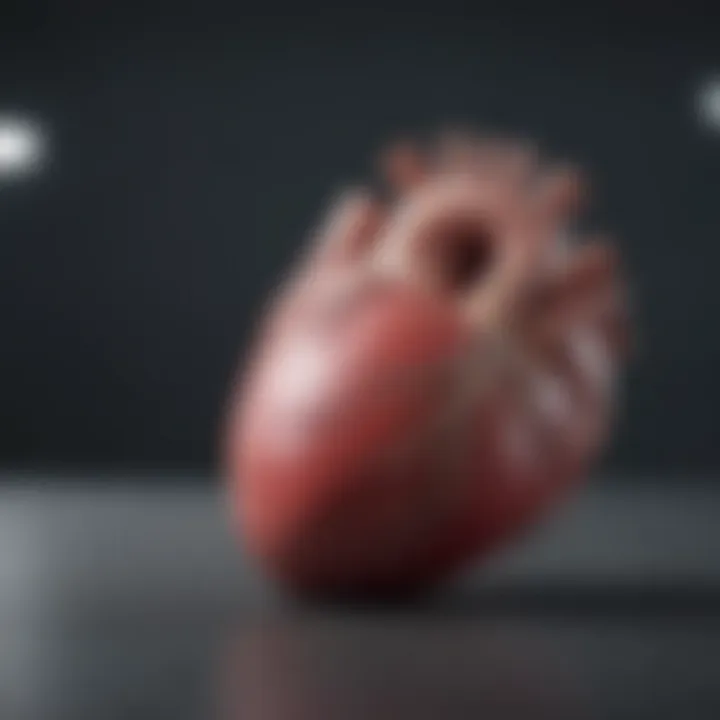Arrhythmia Recognition: Essentials and Impact


Intro
Arrhythmia recognition is a crucial area in the field of cardiology that demands extensive understanding and expertise. This topic involves analyzing the various types of arrhythmias, exploring their implications for patient care, and evaluating the latest diagnostic methods available. Learning about arrhythmias enhances both clinical practice and patient outcomes.
Arrhythmias can impact heart health profoundly. The term covers a variety of heart rhythm disorders, which can lead to serious complications if not diagnosed and managed correctly. Hence, delving into their recognition serves not only to inform healthcare providers but also to educate patients and the public.
An understanding of arrhythmia recognition incorporates several aspects, including the significance of early detection and the role of technology in enhancing patient management. With recent advancements in medical research, the potential for improving how these conditions are diagnosed has increased, leading to better treatment outcomes.
As we progress through this article, we will structure our exploration around the foundational elements of arrhythmia recognition and the implications it carries for clinical practice and medical research.
Research Overview
Summary of Key Findings
Research on arrhythmias has emphasized the necessity for timely recognition. Studies indicate that early detection can significantly reduce risks associated with these conditions. Key findings show that the use of novel diagnostic technologies, such as wearable devices, has improved the monitoring of heart rhythms. Moreover, the inclusion of artificial intelligence in identifying abnormal ECG patterns represents a major leap forward. The fusion of technology and cardiology facilitates better patient care and enables healthcare providers to act swiftly.
Relevance to Current Scientific Discussions
The ongoing discourse in the scientific community often highlights the impact of arrhythmias on public health. There is a growing recognition of their prevalence and the need for widespread awareness. Additionally, current discussions focus on how interdisciplinary approaches can optimize arrhythmia management. Collaboration across fields, such as cardiology, engineering, and data science, is essential in addressing the challenges that arise in arrhythmia detection and treatment.
"A proactive approach to arrhythmia recognition can lead not only to improved individual health outcomes but also to significant advancements in population health strategies."
Understanding these elements is vital for professionals across healthcare settings. Recognizing the multifaceted nature of arrhythmias and their implications will guide improvements in clinical practices, benefitting both patients and providers.
Methodology
Research Design and Approach
Research exploring arrhythmia recognition typically involves a comprehensive review of existing literature, followed by empirical studies. This design helps to synthesize previous findings while contributing new insights. Approaches may vary but often include systematic reviews or meta-analyses that aggregate various research outcomes.
Data Collection and Analysis Techniques
Data related to arrhythmias may be collected through clinical trials, surveys, or observational studies. Common analysis techniques involve statistical analysis to identify trends or correlations among various arrhythmia types and patient outcomes. The use of software tools to process electrocardiogram data has also become prevalent, allowing for enhanced accuracy in data interpretation.
A thorough understanding of these methodologies aids researchers and practitioners alike in contributing to the field of arrhythmia recognition, ultimately promoting a positive impact on patient care.
Prolusion to Arrhythmias
Arrhythmias are irregular heartbeats that can lead to various health complications. Understanding the fundamentals of arrhythmias is crucial for both medical professionals and the general public. This section establishes a foundation for further exploration of the types, diagnosis, and implications of these conditions.
Defining Arrhythmia
Arrhythmia refers to any variation from the normal rhythm of the heart. This can manifest as a heart that beats too slowly, too quickly, or irregularly. It stems from issues with the heart's electrical conduction system. When the electrical impulses that govern heartbeats do not function correctly, arrhythmias occur. This may result from different causes ranging from structural heart problems to electrolyte imbalances.
Furthermore, arrhythmias can be classified into two main types: bradyarrhythmias and tachyarrhythmias. Bradyarrhythmias involve slower than normal heart rates, while tachyarrhythmias denote a heart rate that exceeds normal limits. Some arrhythmias may not cause symptoms, but others can lead to more serious consequences, requiring prompt medical attention.
Importance of Arrhythmia Recognition
Recognizing arrhythmias is vital for effective patient management and outcomes. Undiagnosed arrhythmias may result in complications, including stroke, heart failure, or even sudden cardiac death. Early detection aids in the timely initiation of treatment strategies, which can include medication, lifestyle changes, or even surgery in severe cases.
Healthcare professionals must stay vigilant about potential arrhythmias during examinations. For patients, being aware of the symptoms related to arrhythmias can promote better health monitoring. Key symptoms may include palpitations, dizziness, chest pain, or fainting.
"Identification of arrhythmias significantly influences treatment approaches and patient safety."
In summary, a solid understanding of what arrhythmias are and their importance in clinical settings sets the tone for deeper discussions within this article. As we progress, we will delve into various types of arrhythmias, their mechanisms, diagnostic tools, and implications for future patient care.
Types of Arrhythmias
Understanding the various types of arrhythmias is fundamental for medical professionals and those interested in cardiac health. The classification of arrhythmias not only aids in diagnosis but also influences treatment strategies. Knowing the differences between bradyarrhythmias, tachyarrhythmias, and different types of fibrillation is essential for effective management and education surrounding heart disorders. Each type presents unique challenges and implications for patient care and prognosis.
Bradyarrhythmias
Bradyarrhythmias refer to a slower than normal heart rate, typically defined as a resting heart rate of fewer than 60 beats per minute. While some individuals may experience bradyarrhythmias without any symptoms, it can lead to serious medical issues, especially in older adults and those with other underlying health conditions.
Symptoms often include fatigue, dizziness, and sometimes fainting. These manifestations arise when the heart does not pump enough blood to meet the body’s needs. Conditions contributing to bradyarrhythmias can include natural aging, certain medications, or more severe underlying heart conditions. Management might involve lifestyle modifications or interventions such as a pacemaker placement, depending on the severity of the condition.
Quote: "Bradyarrhythmias must be identified early, as they can escalate into life-threatening situations if left untreated."


Tachyarrhythmias
Tachyarrhythmias, in contrast, are characterized by an abnormally high heart rate, defined as exceeding 100 beats per minute at rest. These can be categorized further into sustained and nonsustained episodes, with the former often requiring immediate medical attention. Common types of tachyarrhythmias include atrial fibrillation, atrial flutter, and ventricular tachycardia.
Individuals experiencing tachyarrhythmias may present with symptoms such as palpitations, shortness of breath, or chest pain. The risk factors include stress, excessive caffeine intake, and underlying health issues like thyroid disease or hypertension. Treatment may focus on restoring normal heart rhythm and preventing potential complications, including stroke or heart failure.
Fibrillation Types
Fibrillation is a more complex type of arrhythmia. In essence, it is a rapid and chaotic heart rhythm that can occur in either the atria or ventricles. Atrial fibrillation is the most common form, where the upper chambers of the heart quiver, leading to inefficient blood flow.
On the other hand, ventricular fibrillation is a life-threatening condition that can lead to loss of consciousness and requires immediate emergency interventions. Understanding the differences in fibrillation types is vital for treatment protocols. Monitoring and management can involve anticoagulants, rhythm control medications, or more advanced interventions like cardioversion or ablation.
In summary, recognizing the different types of arrhythmias enriches our understanding and capacity for optimizing patient care. By distinguishing between bradyarrhythmias, tachyarrhythmias, and fibrillation types, healthcare professionals can tailor their approach effectively, leading to improved patient outcomes and education.
Mechanisms of Arrhythmias
Understanding the mechanisms of arrhythmias is vital for anyone dealing with cardiac health. These mechanisms unveil how irregular heart rhythms arise, offering insights that can help in both detection and treatment. The importance of grasping these concepts cannot be overstated, as they affect clinical practices and patient outcomes.
Electrophysiological Basis
The electrophysiological basis of arrhythmias centers on the heart's electrical system, which regulates heartbeats. The heart operates in a coordinated manner due to specialized cells known as pacemaker cells. These cells generate electrical impulses that initiate heartbeats and ensure their regular rhythm. If the normal conduction system is disturbed due to damage or disease, it may lead to arrhythmias.
Key factors in this process include:
- Ion Channels: These proteins control the flow of ions like sodium, potassium, and calcium in and out of the cardiac cells. Abnormalities in ion channels can lead to patterns of electrical dysfunction.
- Electrical Conduction Pathways: A proper conduction network is critical. Disruptions here can cause delays or blocks, contributing to various arrhythmias.
- Re-entry Circuits: Sometimes, an impulse does not die out, leading to a circuit that perpetuates itself, causing irregular rhythms.
Understanding the electrophysiological aspects aids healthcare professionals in diagnosing and managing arrhythmias efficiently.
Triggers and Risk Factors
Identifying triggers and risk factors for arrhythmias enhances preventative measures and treatment protocols. Various conditions may initiate or exacerbate heart rhythm disturbances, and recognizing them is essential. Common triggers include:
- Excessive Caffeine and Alcohol: Both can influence the heart's electrical behavior, leading to an arrhythmia.
- Stress and Anxiety: These emotional states can elevate the heart rate and induce arrhythmias.
- Electrolyte Imbalances: Essential for normal heart function, imbalances can result from dehydration or certain medications.
Furthermore, many risk factors also play a significant role:
- Chronic Conditions: Diseases like diabetes and hypertension can alter heart structure or function, making arrhythmias more likely.
- Age: The risk of arrhythmias increases with age as heart tissue changes over time.
- Family History: A genetic predisposition to arrhythmias can be present in some families.
Understanding these triggers and risk factors can aid in crafting effective management strategies and educating patients about their heart health.
"Arrhythmias are not just random occurrences but predictable disturbances shaped by underlying mechanisms."
Recognizing these complexities is key to minimizing risks and improving patient results.
Clinical Presentation of Arrhythmias
The clinical presentation of arrhythmias plays a critical role in understanding how these conditions affect patients. Clinical signs and symptoms are often the initial cues that prompt individuals to seek medical attention. Recognizing these manifestations is crucial for timely diagnosis and management. Furthermore, a deeper knowledge of how arrhythmias present offers healthcare professionals the ability to differentiate between types of arrhythmias, leading to more precise treatment strategies.
Symptoms and Signs
Symptoms of arrhythmias can vary significantly based on the type and severity of the condition. Common symptoms include:
- Palpitations: Patients may feel a rapid, fluttering, or pounding heartbeat.
- Dizziness or Lightheadedness: These sensations can arise from reduced blood flow due to irregular heart rhythms.
- Shortness of Breath: Difficulty breathing may occur, particularly during exertion.
- Fatigue: Unexplained exhaustion can stem from the heart's inefficiency.
- Chest Pain: Some patients report discomfort or pain in the chest area, which may signal a more severe issue.
In some cases, patients may be asymptomatic. However, this does not negate the arrhythmia's potential danger. A thorough understanding of these symptoms aids healthcare providers in forming a differential diagnosis, essential for identifying any underlying cardiovascular issues.
Assessment and Diagnosis
The assessment and diagnosis of arrhythmias require a systematic approach. Healthcare providers may utilize several methods to evaluate a patient's condition effectively. Initial patient history and physical examination are paramount. Following this, the main diagnostic tools may include:
- Electrocardiogram (ECG): This fundamental tool records the electrical activity of the heart, allowing for direct observation of arrhythmias.
- Holter Monitoring: A portable device that monitors heart rhythms over 24 to 48 hours, useful for capturing intermittent arrhythmias.
- Event Recorders: These are worn for extended periods and activated by the patient when symptoms occur to allow for a tailored ECG interpretation.
A thorough assessment combining patient symptoms, physical examination, and appropriate diagnostic tools leads to an accurate diagnosis. A proper recognition of the arrhythmia's clinical presentation is essential for optimal patient care and management strategies.
Diagnostic Tools for Arrhythmias
The recognition of arrhythmias is largely dependent on effective and accurate diagnostic tools. These tools are essential for the identification and differentiation of various arrhythmias, as they respond to the unique nuances of each condition. Understanding these diagnostic methods is crucial for both clinicians and researchers. This section outlines the significant tools used in arrhythmia diagnosis, their benefits, and considerations regarding their application in clinical settings.


Electrocardiogram (ECG)
The electrocardiogram, commonly known as ECG or EKG, serves as a cornerstone in arrhythmia detection. This tool measures the electrical activity of the heart over time. By placing electrodes on the skin, the ECG produces a graphical representation of heartbeats, providing visibility into the heart's rhythm and electrical stability.
Benefits of ECG
- Immediate Results: The results from an ECG are instant, allowing for quick clinical decisions.
- Detects Various Arrhythmias: It can identify a range of conditions, from atrial fibrillation to bradycardia.
- Non-Invasive: The procedure is simple and poses minimal risk to the patient.
Despite its widespread use, ECG does have limitations. It requires specific technical skills to interpret the results accurately, and variations in patient position or movement can affect the readings.
Holter Monitoring
Holter monitoring is a continuous form of ECG that records heart rhythms over 24 to 48 hours. It is particularly useful for identifying intermittent arrhythmias that may not appear in a standard ECG.
Key Features of Holter Monitoring
- Extended Monitoring: Captures data throughout daily activities, providing a comprehensive view of the heart's rhythms in various contexts.
- Patient Compliance: Since patients wear the device during their normal routines, it increases the likelihood of capturing arrhythmias that might occur sporadically.
However, this method does present challenges such as potential discomfort from wearing the device, and the data analysis can be complex and time-consuming.
Event Recorders
Event recorders are another diagnostic tool designed for patients who experience infrequent arrhythmias. These devices allow patients to manually activate recording during symptoms. The recordings are then transmitted to a healthcare provider for evaluation.
Advantages of Event Recorders
- On-Demand Monitoring: Patients can record heart activity in real-time when symptoms arise, leading to better correlation between symptoms and heart rhythm.
- Longer Monitoring Periods: Some devices can be worn for weeks or even months, capturing rare events that a standard ECG cannot.
Despite their benefits, there is a reliance on patients to activate the device appropriately. Missed activations can lead to gaps in data.
"Effective use of these diagnostic tools is key to timely arrhythmia management, ultimately improving patient outcomes."
In summary, the integration of ECG, Holter monitoring, and event recorders forms a robust framework for diagnosing arrhythmias. Each tool offers its unique strengths and limitations, making it important for healthcare professionals to select the appropriate method based on individual patient needs. Understanding the intricacies of these diagnostic tools enhances not only patient care but also contributes to the overall understanding of arrhythmias.
Recent Advances in Arrhythmia Detection
The landscape of arrhythmia detection is rapidly evolving. With advances in technology and methodology, we have seen significant improvements in how arrhythmias are recognized and managed. The importance of these developments cannot be overstated. Enhanced detection capabilities lead to better diagnosis and consequently to more effective management strategies.
The integration of new technologies such as wearable devices and artificial intelligence into clinical practice offers great potential. These advancements present unique benefits, such as real-time data collection and patient monitoring, which can significantly improve outcomes. However, considerations around data privacy, accuracy, and accessibility also come into play. Thus, understanding these advances within the broader context of healthcare is crucial for both patients and professionals.
Wearable Technology
Wearable technology has become a cornerstone in arrhythmia detection. Devices like smartwatches and fitness trackers now have built-in ECG capabilities, enabling continuous monitoring of heart rhythms. This technology allows for the collection of data outside traditional clinical settings, providing insights into heart health during everyday activities.
The primary benefits of wearable devices include:
- Real-time monitoring: Patients can receive immediate alerts about irregular heart rhythms, allowing for timely medical intervention.
- Data collection: Wearables accumulate valuable data over time, which can assist healthcare providers in identifying patterns and tailoring treatment plans.
- Accessibility: These devices democratize access to heart monitoring, enabling individuals to take a proactive role in their health management.
However, it is essential to acknowledge the limitations and challenges associated with wearables, such as the potential for false positives and the need for proper user education to maximize the advantages.
Artificial Intelligence in Diagnosis
The application of artificial intelligence (AI) is revolutionizing arrhythmia diagnosis. Machine learning algorithms are being developed to analyze complex ECG data with unprecedented accuracy. AI systems are trained to identify arrhythmias that may be missed by human observers, effectively augmenting diagnostic capabilities.
Key aspects of AI's role include:
- Enhanced accuracy: AI algorithms can detect subtle changes in heart rhythm patterns that human eyes may overlook.
- Predictive analytics: AI can analyze historical patient data to predict future arrhythmia events, enabling preventive care approaches.
- Efficiency: Automation of data interpretation reduces the burden on healthcare professionals, allowing them to focus on direct patient care.
Despite these advances, there are ethical and practical challenges with the use of AI. Issues surrounding data security and patient consent must be addressed to ensure the responsible use of technology in healthcare.
"The integration of wearable technology and artificial intelligence in arrhythmia detection represents a significant turning point in cardiac care, offering exciting possibilities for patient monitoring and management."
As we continue to refine these technologies, the hope is to integrate them seamlessly into standard care practices, improving detection and management of arrhythmias for patients worldwide.
Implications for Patient Care
Arrhythmia recognition plays a crucial role in improving patient care. Understanding how arrhythmias impact health is essential for effective management and treatment. The implications of this knowledge extend beyond diagnosis; they influence therapeutic strategies, monitoring, and overall quality of life for patients.


Management Strategies
Management of arrhythmias must be tailored to the type and severity of the condition. It can include:
- Medication: Various drugs, such as beta-blockers, antiarrhythmics, and anticoagulants, are often prescribed to control heart rate and prevent clot formation. Each medication has specific indications based on the type of arrhythmia.
- Cardioversion: This procedure may be necessary for certain arrhythmias where immediate correction is essential. Cardioversion can be chemical, using medications, or electrical, utilizing controlled shocks to restore a normal rhythm.
- Implantable Devices: Pacemakers and implantable cardioverter-defibrillators (ICDs) are options for patients with severe arrhythmias. These devices help maintain a proper heart rhythm and can significantly reduce the risk of mortality.
- Lifestyle Modifications: Encouraging patients to adopt healthier lifestyles can prevent the onset or worsening of arrhythmias. Encouragement of regular exercise, a balanced diet, stress management, and avoidance of alcohol and smoking can play significant roles in arrhythmia control.
Role of Patient Education
Patient education cannot be overstated. Informed patients are better equipped to manage their conditions and make necessary lifestyle changes. Key components of effective education include:
- Understanding the Condition: Patients should grasp what arrhythmia is and how it affects their overall health. This understanding promotes adherence to treatment plans and helps them recognize symptoms that may require immediate attention.
- Navigating Treatment Options: Patients must know available treatments and their advantages and disadvantages. Knowing what to expect from medications or procedures reduces anxiety and enhances compliance.
- Self-Monitoring: When patients learn how to monitor their own symptoms, they can detect changes early. Initiatives like keeping a symptom diary can also help healthcare providers tailor treatments more effectively.
"Education empowers patients, turning them from passive recipients of care into active participants in their health journey."
By recognizing the nuances of arrhythmia management and emphasizing the importance of education, healthcare professionals can significantly enhance patient care. The integration of patient knowledge into management strategies leads to a more individualized treatment approach and ultimately improves outcomes.
Future Directions in Arrhythmia Research
The field of arrhythmia research is rapidly evolving. Innovations in technology and methodology are essential for improving patient outcomes. Future directions focus on cutting-edge treatments and enhanced understanding of the disease dynamics. There are many facets to consider, including emerging therapies that offer hope and the role of long-term studies in shaping future guidelines.
Emerging Therapies
Emerging therapies in the realm of arrhythmia seek to provide more effective approaches to diagnosis and treatment. Options such as catheter ablation have shown promise in treating specific arrhythmias. This method uses heat or cold to destroy abnormal electrical pathways in the heart. Another area of study includes the development of newer antiarrhythmic drugs. Some of these agents aim to reduce side effects commonly associated with existing medications.
Gene therapy is also a burgeoning field offering potential game-changing strategies. By targeting the genes responsible for certain arrhythmias, clinicians can offer more personalized treatment plans. Furthermore, novel devices, such as implantable cardioverter-defibrillators, have been refined, allowing for better monitoring and intervention in complex cases.
"Innovations in therapeutic approaches redefine how practitioners understand and manage arrhythmias."
Importance of Longitudinal Studies
Longitudinal studies contribute significantly to the understanding of arrhythmias over time. Such studies track patients for extended periods, providing insights into the natural progression of arrhythmias and their long-term effects. This type of research helps establish more accurate risk profiles and better informs treatment options.
By investigating the long-term efficacy of various therapies, researchers can identify the best practices for management. These studies can also uncover subtle trends and correlations, paving the way for new hypotheses and treatment modalities. In addition, they reveal disparities in outcomes based on demographics or other factors, addressing inequities in arrhythmia treatment.
Challenges in Arrhythmia Recognition
Arrhythmias are complex and can present unique challenges in their recognition. Understanding these challenges is crucial for effective diagnosis and management. Misdiagnosis can lead to inappropriate treatments. This can further complicate patient outcomes and increase healthcare costs. Addressing barriers to accurate diagnosis and disparities in access to care can enhance overall patient care.
Barriers to Accurate Diagnosis
Diagnosing arrhythmias accurately is often complicated. One prominent barrier includes the transient nature of some arrhythmias. For instance, patients may experience intermittent symptoms. These symptoms do not always coincide with medical evaluations. As a result, arrhythmias can go undetected.
Another barrier is the reliance on traditional diagnostic tools, such as the electrocardiogram (ECG). Although helpful, ECGs sometimes miss subtle arrhythmic events. This can lead to underdiagnosis or misdiagnosis. The interpretation of ECGs can also be challenging, requiring specialized training and experience.
Furthermore, a lack of patient awareness about arrhythmia symptoms complicates disease recognition. Patients may misinterpret palpitations or dizziness as benign. Therefore, raising public awareness of potential symptoms is vital.
"Improving awareness among patients can lead to earlier detection and better management of arrhythmias."
Disparities in Access to Care
Access to quality healthcare varies significantly across different populations. This disparity poses a substantial challenge in arrhythmia recognition. In many regions, there is a shortage of specialized cardiac care. Patients in underserved areas may face difficulties accessing expert evaluations. This limits timely diagnosis and appropriate management of their conditions.
Socioeconomic factors play a role as well. Individuals with lower income might not afford regular check-ups or advanced diagnostic tools. Cultural attitudes towards healthcare can also impact patients' willingness to seek help. Enhancing access to care is paramount to ensure all patients receive appropriate evaluations for arrhythmias.
Efforts must focus on increasing healthcare resources in underserved areas. Community health initiatives can also promote awareness. By addressing these disparities, we can improve arrhythmia recognition and patient outcomes.
Epilogue
Understanding arrhythmia recognition is crucial in the medical field. It informs both diagnostics and treatment strategies that directly impact patient outcomes. Arrhythmias can range from benign forms to life-threatening conditions. Therefore, accurately recognizing them is essential for providing optimal care. This article discussed various aspects of arrhythmias, focusing on their types, mechanisms, and the latest diagnostic technologies available.
Summary of Key Insights
By evaluating the content, several key insights emerge regarding arrhythmias:
- Diverse Types: There are various types of arrhythmias, including bradyarrhythmias and tachyarrhythmias, each requiring specific recognition strategies.
- Importance of Technology: Advances in diagnostic tools such as wearable technology and artificial intelligence are paving new paths for arrhythmia detection and management.
- Patient Care Implications: A comprehensive understanding of arrhythmias enhances management strategies and underscores the significance of patient education in improving health outcomes.
The Path Forward
Looking ahead, further research is essential in the field of arrhythmia studies. Emerging therapies will likely offer new treatment options, and longitudinal studies can provide deeper insights into the long-term effects of different arrhythmias and their management.
- Collaboration: An interprofessional approach combining cardiologists, nurses, and technologists is essential for more effective arrhythmia recognition and treatment.
- Access to Care: Addressing inequalities in healthcare access can greatly improve diagnosis rates among diverse populations.
- Emphasis on Training: Medical staff must receive ongoing training in arrhythmia recognition techniques and emerging technologies to improve their diagnostic skills.
A proactive approach in research and education will ultimately contribute to better arrhythmia management and improved patient care.



